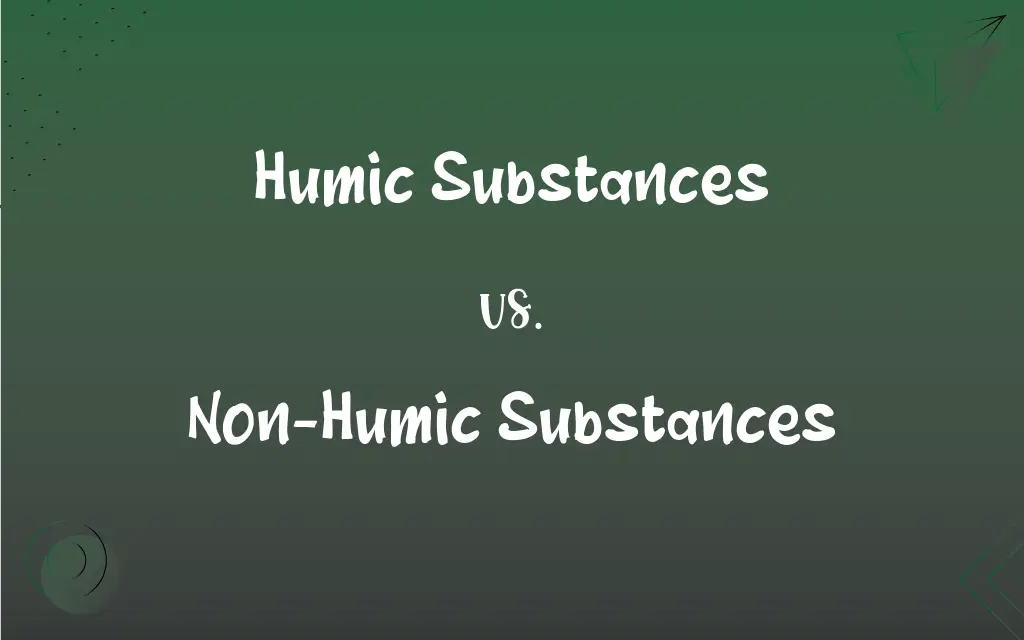Humic Substances vs. Non-Humic Substances: What's the Difference?
Edited by Aimie Carlson || By Harlon Moss || Published on February 1, 2024
Humic substances are complex organic compounds formed from plant and animal decay, crucial for soil health, while non-humic substances include simpler organic and inorganic matter not derived from humification.

Key Differences
Humic substances are composed of long-chain organic molecules resulting from the decay of organic matter. Non-humic substances encompass a broader range of organic and inorganic materials not derived from humification processes.
Humic substances improve soil structure, water retention, and nutrient availability. Non-humic substances, including minerals and fresh organic matter, also contribute to soil fertility but differ in their function and chemical properties.
Humic substances are typically dark in color and can be soluble or insoluble in water, depending on pH. Non-humic substances vary widely in appearance, solubility, and chemical behavior.
In agriculture, humic substances are valued for enhancing plant growth and soil health. Non-humic substances can range from beneficial (like certain minerals) to detrimental (like pollutants) for plant and soil health.
Humic substances are often extracted for use in agricultural products. Non-humic substances, such as fertilizers and conditioners, have diverse applications in agriculture and environmental management.
ADVERTISEMENT
Comparison Chart
Composition
Complex organic molecules
Simple organic and inorganic materials
Origin
Decay of organic matter
Various sources, not limited to decay
Role in Soil
Improve structure, nutrient availability
Diverse, depends on the specific substance
Physical Properties
Dark color, variable solubility
Varies widely
Impact on Plant Growth
Generally beneficial for growth
Ranges from beneficial to harmful
ADVERTISEMENT
Humic Substances and Non-Humic Substances Definitions
Humic Substances
They are key components of humus, the organic fraction of soil.
Humic substances contribute to the dark color of rich soil.
Non-Humic Substances
Non-humic substances can be either beneficial or detrimental to soil health.
Lime, a non-humic substance, is used to adjust soil pH.
Humic Substances
Humic substances enhance water retention and soil fertility.
Farmers use humic substances to boost crop yields.
Non-Humic Substances
Non-humic substances can include synthetic compounds.
Pesticides in soil are classified as non-humic substances.
Humic Substances
Humic substances are organic compounds in soil from decomposed matter.
Adding humic substances to soil improves its nutrient content.
Non-Humic Substances
These substances vary in solubility and chemical properties.
Inorganic fertilizers, as non-humic substances, dissolve easily in water.
Humic Substances
Humic substances bind with metal ions, affecting soil chemistry.
Humic substances can help detoxify soils with heavy metals.
Non-Humic Substances
Non-humic substances include simple organic matter and minerals.
Fresh plant residues in soil are considered non-humic substances.
Humic Substances
These substances are soluble in alkaline solutions.
In an alkaline pH, humic substances become more active.
Non-Humic Substances
They are not derived from the humification process.
Sand and clay in soil are typical non-humic substances.
FAQs
How do humic substances form?
Through the decomposition of plant and animal matter over time.
What is an example of a non-humic substance?
Fresh plant residues, minerals, and synthetic fertilizers.
What are non-humic substances?
Organic and inorganic materials in soil not derived from humification.
Why are humic substances important for soil?
They improve soil structure, fertility, and water retention.
Do humic substances affect soil pH?
They can influence pH by interacting with soil minerals and ions.
What role do non-humic substances play in soil?
They contribute to soil properties and nutrient content, but their roles vary.
Can humic substances be extracted?
Yes, they are extracted for use in agricultural products.
How do non-humic substances affect water retention in soil?
It depends on the substance; some may improve or decrease water retention.
What are humic substances?
Complex organic compounds in soil from decomposed organic matter.
Do humic substances bind with metals?
Yes, they can chelate metal ions, affecting soil chemistry.
How do humic substances influence plant growth?
They provide essential nutrients and improve soil health for better growth.
Are all non-humic substances beneficial for soil?
No, their impact ranges from beneficial (like lime) to harmful (like pollutants).
Can non-humic substances be part of soil amendments?
Yes, many soil amendments like fertilizers are non-humic.
Are humic substances always beneficial?
Generally, yes, but their effectiveness can vary based on soil type and conditions.
What is the primary source of non-humic substances?
They come from a variety of sources, including natural and synthetic origins.
How do farmers use humic substances?
As soil conditioners to enhance nutrient availability and crop yield.
Can non-humic substances be synthetic?
Yes, they include both natural and synthetic materials.
Can non-humic substances be removed from soil?
Some, like pollutants, can be removed or mitigated through various soil treatments.
What's the color of humic substances?
They are typically dark, often contributing to the color of rich soil.
What is the difference in solubility between humic and non-humic substances?
Humic substances' solubility varies with pH, while non-humic substances have diverse solubility properties.
About Author
Written by
Harlon MossHarlon is a seasoned quality moderator and accomplished content writer for Difference Wiki. An alumnus of the prestigious University of California, he earned his degree in Computer Science. Leveraging his academic background, Harlon brings a meticulous and informed perspective to his work, ensuring content accuracy and excellence.
Edited by
Aimie CarlsonAimie Carlson, holding a master's degree in English literature, is a fervent English language enthusiast. She lends her writing talents to Difference Wiki, a prominent website that specializes in comparisons, offering readers insightful analyses that both captivate and inform.






































































